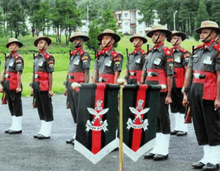Paramilitary forces of India
- For police forces formerly considered paramilitary forces, see Central Armed Police Forces
| Military Manpower | |
|---|---|
| Active troops | 1,395,100 (2nd) |
| Reserve forces | 2,142,800 (7th) |
| Paramilitary forces and CAPF |
1,403,700 (1st) |
| Components | |
| Indian Army | |
| Indian Air Force | |
| Indian Navy | |
| Paramilitary forces of India | |
| Central Armed Police Forces | |
| Strategic Nuclear Command | |
| History | |
| Military history of India | |
| Ranks | |
| Air Force ranks and insignia | |
| Army ranks and insignia | |
| Naval ranks and insignia | |
The term "paramilitary forces" in India has not been defined in any acts or by authorities officially, however they are currently used to refer to following forces
- The Assam Rifles (AR) - 63,747 personnel[1] (led by Indian Army officers reporting to the Ministry of Home Affairs)
- The Special Frontier Force (SFF) 10,000 personnel (led by Indian Army officers reporting to Indian Intelligence)
Following five forces which come under Indian Home Ministry were earlier considered paramilitary forces, but from March 2011 have been classified as Central Armed Police Forces to avoid confusion[2]
- Central Reserve Police Force (CRPF) - 313,678 personnel,
- Border Security Force (BSF) - 257,363 personnel,
- Indo-Tibetan Border Police (ITBP) - 89,432 personnel,
- Central Industrial Security Force (CISF) - 144,418 personnel,
- Sashastra Seema Bal (SSB) - 76,337 personnel.
Assam Rifles

The Assam Rifles can trace their lineage back to a paramilitary police force that was formed under the British in 1835 called Cachar Levy. Since then the Assam Rifles have undergone a number of name changes before the name Assam Rifles was finally adopted in 1917.[3] Over the course of its history, the Assam Rifles and its predecessor units have served in a number of roles, conflicts and theatres including World War I where they served in Europe and the Middle East, and World War II where they served mainly in Burma. In the post World War II period the Assam Rifles has expanded greatly as has its role. There are currently 46 battalions[4] of Assam Rifles under the control of the Indian Ministry of Home Affairs (MHA) and they perform many roles including the provision of internal security under the control of the army through the conduct of counter insurgency and border security operations, provision of aid to the civil power in times of emergency, and the provision of communications, medical assistance and education in remote areas.[5] In times of war they can also be used as a combat force to secure rear areas if needed.
Special Frontier Force
The Special Frontier force (SFF) is paramilitary unit of India. It was conceived in the post Sino-Indian war period as a guerrilla force composed mainly of Tibetan who are residents of India whose main goal was to conduct covert operations behind Chinese lines in case of another war between the People's Republic of China and India.
Based in Chakrata, Uttarakhand, SFF is also known as the Establishment 22.[6][7] The force was put under the direct supervision of the Intelligence Bureau, and later, the Research and Analysis Wing, India's external intelligence agency.[8]
See also
References
- ↑ "MHA Annual Report 2016-2017" (PDF). Archived (PDF) from the original on 8 August 2017.
- ↑ "Office Memorandum" (PDF). MHA. MHA, GoI. Archived (PDF) from the original on 17 January 2016. Retrieved 26 August 2015.
- ↑ The Assam Frontier Police (1883), the Assam Military Police (1891) and Eastern Bengal and Assam Military Police (1913), before finally becoming the Assam Rifles in 1917. See Sharma 2008.
- ↑ See History of the Assam Rifles Archived 10 March 2009 at the Wayback Machine.
- ↑ Sharma 2008.
- ↑ "Army Establishment". Archived from the original on 17 January 2016. Retrieved 25 February 2015.
- ↑ The SFF became morle famous within the administration as the "Establishment 22" because its first Inspector General (IG) Major Gen. Sujan Singh, a Military Cross holder and a legendary figure in the British India Army. Singh commanded the 22nd Mountain Regiment during World War II in Europe and a Long Range Desert Squadron (LRDS) in north Africa.
- ↑ "Bollywood Sargam - Special: Tibetan faujis in Bluestar". Archived from the original on 2 May 2013. Retrieved 25 February 2015.
